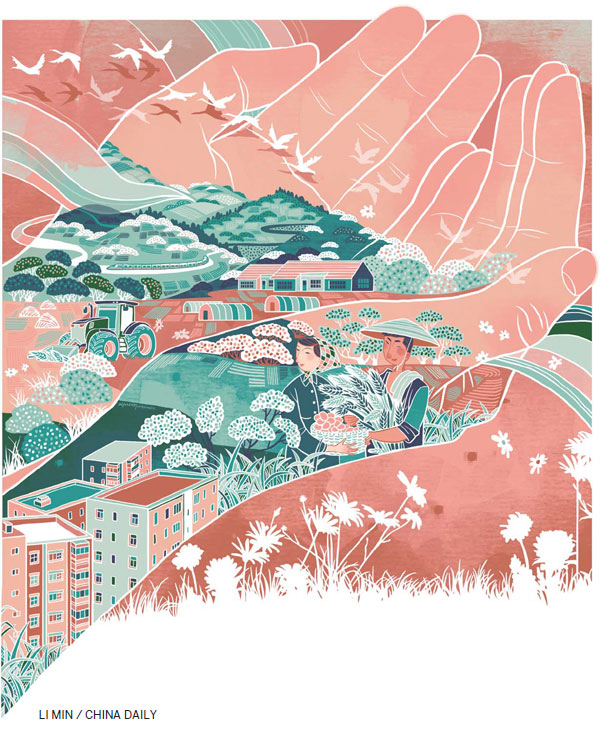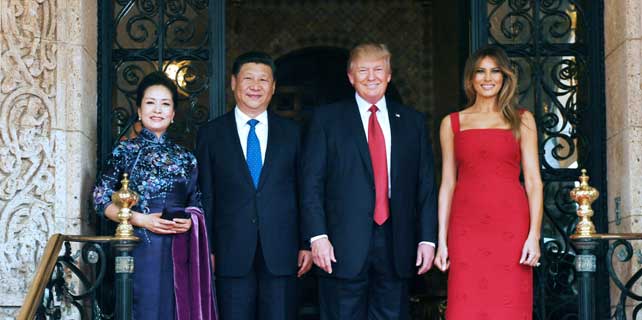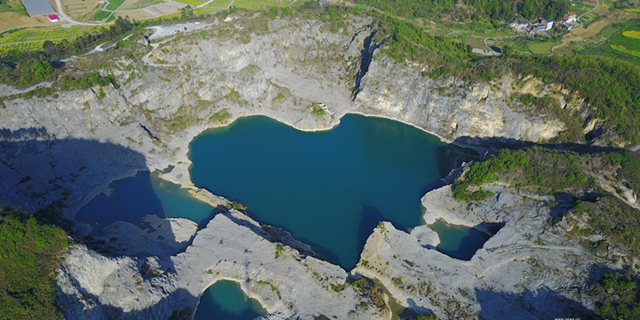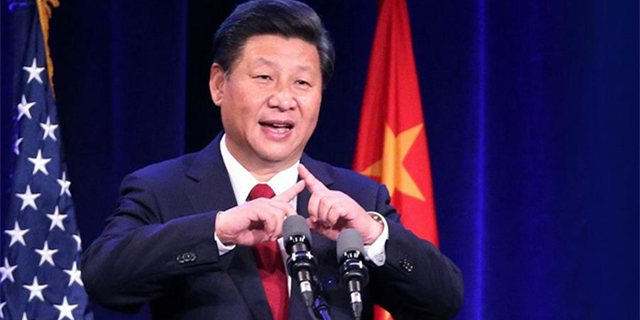At war with poverty

Government's all-out attack on hardship is yielding remarkable results throughout China
Few people used the narrow road in the mountain town of Moudao before 2011. People in the area could barely harvest enough food to eat from the limited farmland, which supported only potatoes and corn.
This forced 80 percent of adults to move away to make a living, says Qin Taixiang, a local writer who has chronicled the town's development for many years.
"Now the road has been widened to from 3.5 to 12 meters, it's common to see traffic jams in summer. Many families have moved into new houses and bought cars," says the 56-year-old resident of the town in the Enshi Tujia and Miao autonomous prefecture, Hubei province.
The great changes of Moudao well illustrate the "targeted poverty alleviation" measures the Chinese government has called for in the country's campaign to eradicate poverty and build a moderately prosperous society by 2020. The central government has asked for targeted measures to ensure that assistance reaches poverty-stricken villages and households.
Though the town is only about 70 kilometers away from the Wanzhou district of Chongqing municipality, the temperature in Moudao rarely exceeds 20 C during the summer, about half the average temperature in Wanzhou.
It stands 1,400 meters above sea level, and about 70 percent of the area is covered by trees, which results in high levels of negative ions - thought to promote feelings of harmony and happiness, says Wang Houjun, mayor of the town.
The excellent natural environment attracted people from Wanzhou to escape the heat in summer, and this inspired the local government's idea of developing real estate tourism in 2011. With local conditions a selling point and with a preferential investment policy from government, the area succeeded in attracting developers. They had invested 8 billion yuan ($1.2 billion; 1.12 billion euros; 983.7 million) in the town as of the end of 2016, Wang says.
"In 2015, the average per capita income jumped to 9,636 yuan from about 3,000 yuan in 2011. In the eight villages near the downtown area, the average household savings of the 10,000 residents reached 732,000 yuan as a result of flourishing real estate tourism," he says.
The Central Committee of the Communist Party of China and the State Council jointly released instructions for poverty alleviation in December 2015, suggesting more targeted and precise measures be taken to help people living in poverty in rural areas to reach basic living standards by 2020.
The document suggested a series of measures, including developing industries, improving education and medical services, building adequate infrastructure and facilities, helping migrant workers find jobs and relocating people living in hostile conditions and fragile environments.
Guided by the policy, a database was requested to record the basic information of indigent people throughout the country, enabling measures even more specific than those taken in Moudao to reach each poverty-stricken family.
"The methods of poverty relief used in the past no longer work when it comes to the most impoverished families. Targeted relief and customized policies are needed to help each household," Wang Sangui, a poverty expert from Renmin University of China in Beijing, told Xinhua.
"Identifying the needs of the poor is the first step in the poverty relief battle, and only by fully understanding the problem can policymakers deliver the targeted measures proposed by the central authorities," he says.
China has lifted 700 million people out of poverty in the past 30 years.
Alleviation of hardship has always been at the top of the central government's agenda. President Xi Jinping has inspected poverty eradication programs in about 20 provinces and 180 villages since the 18th National Congress of the Party, held in November 2012.
"Whether we have achieved a moderately prosperous society or not, you can get an answer by looking at people in rural areas," Xi said. During a visit in Jiangxi province in February 2016 he added: "Not a single family living in poverty is to be left behind."
While attending a panel discussion with a delegation from the Xinjiang Uygur autonomous region during the annual session of the National People's Congress on March 10, Xi emphasized the implementation of tailored poverty relief policies and precision measures in poverty-stricken areas, especially in southern Xinjiang, which he said is the main area for poverty alleviation work.
Premier Li Keqiang has also visited many poverty-stricken areas. On Jan 23, Li visited a poor village in a suburb of Zhaotong city, Yunnan province. The per capita income of the village was about 3,044 yuan in 2016. Villagers grow corn and potatoes and some work in cities to make a living.
The barren land is no longer suitable for living on, and the villagers should be relocated with more government support, including favorable policies and funds, Li said. He called for innovative ways to relocate poverty-stricken families to more habitable locations.
China's 13th Five-Year Plan for Economic and Social Development has codified the central leadership's poverty-reduction decision into a scheme that is operable in practice, according to a white paper titled China's Progress in Poverty Reduction and Human Rights, issued on Oct 17, 2016.
Poverty reduction has been made an important part of one of China's five-year plans for the first time, and helping the poor has been made obligatory. Also, for the first time, the heads of Party committees and governments of relevant provinces and autonomous regions have signed letters of commitment on poverty elimination. Similar documents have been signed by leaders at lower levels.
The central government has allocated 40.4 billion yuan since 2012, which has helped leverage investment of another 141.2 billion yuan, to resettle poor people. This will help relocate 5.91 million people. Local governments also allocated 38 billion yuan of their poverty relief funds, resettling 5.8 million people, the white paper said.
In spite of such remarkable achievements, China's fight against poverty remains tough and the country has entered a crucial stage in its efforts. It still had 55.75 million people living in poverty at the end of 2015, and the State has pledged to lift 10 million people out of such conditions every year by developing specialty industries, transferring employment, relocation and social security coverage, the white paper said.
The government has summoned almost all its powers to deal with the issue. With the government as the main force, social organizations and private enterprises have also been called on to contribute.
On Dec 4, 2014, the State Council issued a circular that vowed to encourage private enterprises, organizations and individuals to participate in poverty alleviation. Enterprises investing and creating jobs in poor regions will enjoy more favorable policies in taxation and other fields, the circular said.
The government's special fiscal fund for poverty relief, industry and social powers are the three main drivers in the nationwide poverty alleviation campaign, says Tan Xuewen, director of the Poverty and Welfare Research Office at the Chinese Academy of Social Sciences' Rural Development Institute.
As for social powers, there are various forms, including regional cooperation between East and West China carried out by government institutions and enterprises. It also involves enterprises, individuals, social organizations and international organizations. Enterprises within poverty-stricken areas are particularly involved in poverty relief, Tan says.
Early 2016, 51 central government-owned enterprises jointly established an industrial investment fund of 12.2 billion yuan to promote economic development in poor regions. That fund is expected to expand to 100 billion yuan in the near future, says Liu Yongfu, director of the State Council Leading Group Office of Poverty Alleviation and Development, at the office's annual national meeting held in late 2016.
He also said a total of 21,992 private enterprises had pledged to help 21,251 registered poor villages. One of the companies, Evergrande Group, decided in late 2015 to invest 3 billion yuan over three years to help Dafang county in Guizhou province.
Tan says, however, it doesn't necessarily mean that investment will yield good results. "It needs some preconditions for enterprises to work in poverty relief. Stable operations of these companies do matter and their business should also have good market prospects. It's also very important for enterprises to be willing to shoulder social responsibility and establish a clear, fair and reasonable benefit allocation system with residents," he says.
China began to accept international aid after the flood disaster that ravaged the upper reaches of Yangtze River in 1981. International organizations gave the country new poverty alleviation models in 1990s, including small loans.
After 2000, the Chinese government also tried the small loan model in rural areas, but such loans issued by the government have a comparatively high bad debt rate. In contrast, small loans issued by mutual support associations have very few defaults.
"Petty loans from a farmers' mutual support association are directly managed by farmers, making the costs low. All members of the association know each other very well. People will be under pressure from their neighbors if they refuse to repay," Tan says.
Wu Chen, director of the China Resources Institute, a nonprofit research institute based in Beijing, says there have been many grassroots organizations involved in poverty relief, although it was an international organization that started things as an NGO 30 years ago.
"Previously, with enough funds, NGOs could stay and work in rural areas for a long time. Now very few can support that. Also, NGO workers got relatively high salaries then, but that is not the case anymore."
Wu, however, is confident about the long-term significance of NGOs' work in poverty alleviation.
"We hope we can help the village bring in tourists and help the community change not only economically but spiritually," she says.
houliqiang@chinadaily.com.cn









